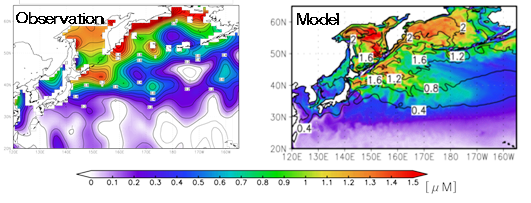Humio Mitsudera
Numerical simulation of three dimensional pathways of the nutrient materials in the North Pacific Ocean and its analysis
Research summary
Numerical modeling of materials circulation will be conducted aiming at elucidating mechanisms that cause abundant primary production in the western North Pacific Ocean, as well as in the Sea of Okhotsk and the Bering Sea. It is important to identify three dimensional oceanic pathways of nutrient materials including intermediate layers, as to how nutrients are brought to the surface layer to cause phytoplankton blooms. So far, we have paid attention to iron pathways. In the present study, we are also aiming at elucidating macro nutrient pathways such as those of phosphate. To elucidate the nutrient pathways, we will utilize the following two types of numerical models:
- A western North Pacific biogeochemical model with 0.5° resolution that includes enhanced tidal mixing along the Kuril Islands and the Aleutian Islands. This model has reproduced nutrient transport of iron of the seasonal time scale. Based on this model performance, numerical experiments will be conducted on long-term variations in the present study.
- A high-resolution North Pacific biogeochemical model that couples with tidal forcing. This model is a novel one, in which vertical mixing over topography is evaluated through turbulent closure model where tidal currents produce bottom turbulence layer. Long-term historical hindcast experiments, which incorporates the 18.6-year-period tidal forcing, will be conducted with this model.
In addition to the numerical experiments above, we will produce new high-resolution datasets of sea surface nutrients that include marginal seas, i.e., the Sea of Okhotsk and the Bering Sea. These datasets are utilized to elucidate the interannual variations of nutrients as well as evaluate the performance of the numerical models. It is a great opportunity for the preset study to collaborate with an intensive observation off the coast of the Kamchatka Peninsula in 2018 to elucidate the pathways of nutrients.
Principal Investigator
Humio Mitsudera, Institute of Low Temperature Science, Hokkaido University, Professor,
Physical Oceanography, principal investigator.
Collaborators
Tomohiro Nakamura, Institute of Low Temperature Science, Hokkaido University, Lecturer,
Physical Oceanography, development of the high-resolution North Pacific materials circulation model.
Takuya Nakanowatari, National Polar Institute, Researcher
Physical Oceanography, North-western Pacific materials circulation model.
Sayaka Yasunaka, JAMSTEC, Researcher
Physical Oceanography, development and analysis of a new nutrient datasets
Hatsumi Nishikawa, Institute of Low Temperature Science, Hokkaido University, Lecturer,
Physical Oceanography, development of the high-resolution North Pacific materials circulation model.

Consumption of PO4 between March and August. (Left) Observation by World Ocean Atlas, (right) Model.

